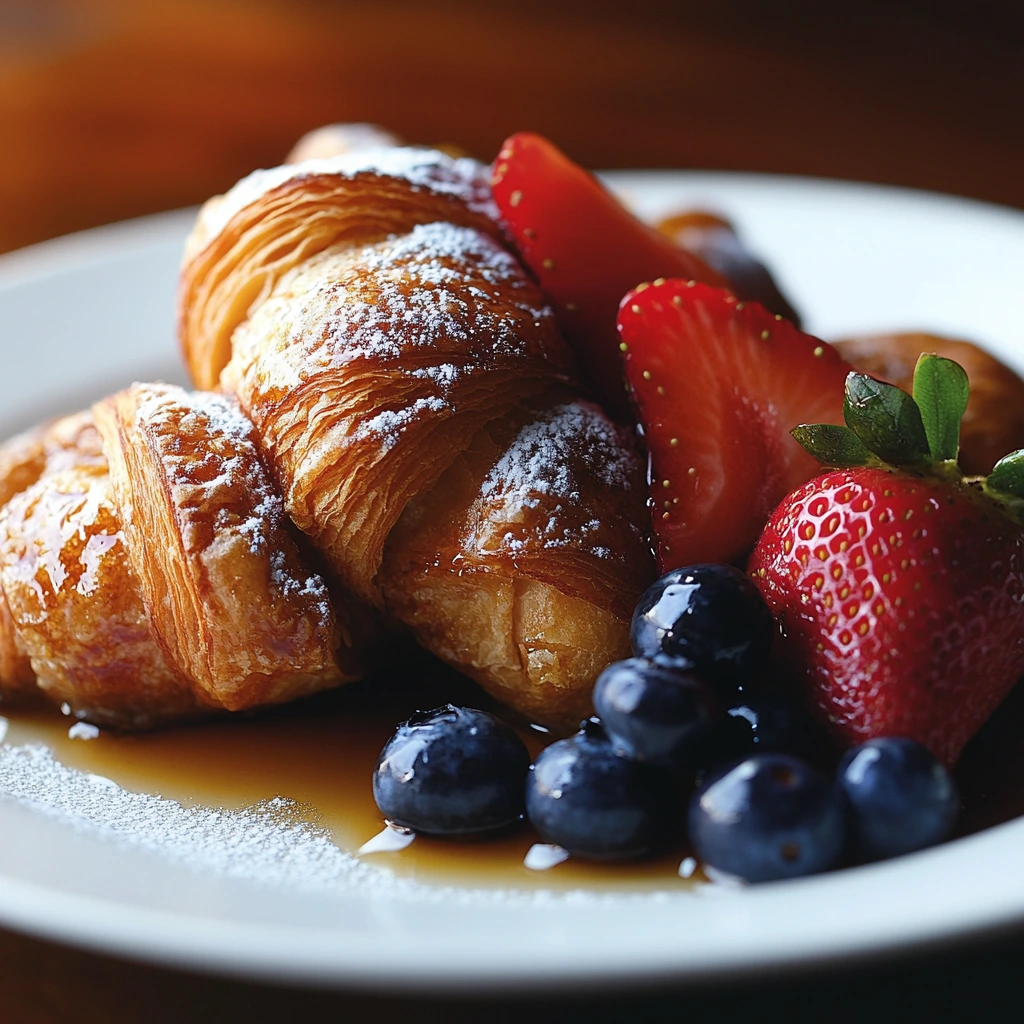1. What is Croissant French Toast?
Croissant French Toast is an innovative twist on the classic French toast recipe. Instead of using traditional bread, this delightful dish features buttery, flaky croissants soaked in a rich, custardy mixture of eggs, milk, and spices. Pan-fried to golden perfection, it combines the soft, creamy texture of French toast with the luxurious layers of a croissant.
2. Why is it a Trending Breakfast Delight?
Croissant French Toast is quickly becoming a favorite breakfast indulgence for food enthusiasts worldwide. Its rise in popularity can be attributed to its unique combination of flavor and texture—decadent yet familiar. The dish perfectly balances a crispy exterior with a soft, pillowy center, creating a restaurant-worthy experience right at home. Additionally, with the current trend of elevating comfort food, foodies and home cooks alike are drawn to this easy yet gourmet dish.
3. History and Origin of Croissant French Toast
1. The French Connection: Origins of Croissants
The croissant may be a French favorite, but it actually started in Austria. The original kipferl, a crescent-shaped pastry, made its way to France in the 17th century. French bakers later transformed it into the buttery, flaky croissant we know and love today.
2. Fusion of French Toast and Croissants
French toast, or pain perdu, was created to use up stale bread by soaking it in eggs and milk before frying. Combining croissants with French toast takes this idea to the next level. The result? A rich, crispy, and indulgent breakfast that blends two classics into one delicious dish.
4. How to Make Croissant French Toast: A Step-by-Step Guide

1. Ingredients You Will Need
To make this delicious breakfast, you’ll need:
- 4 large croissants (preferably day-old)
- 2 large eggs
- 1/2 cup milk (or cream for extra richness)
- 1 teaspoon vanilla extract
- 1/2 teaspoon ground cinnamon (optional)
- 1 tablespoon sugar
- Butter for cooking
- Toppings: maple syrup, powdered sugar, fresh berries, or whipped cream
2. Preparing the Custard Mixture
- In a large bowl, whisk together the eggs, milk, vanilla extract, cinnamon, and sugar.
- Mix until smooth and well combined.
- Pour the mixture into a shallow dish—it’s easier to dip the croissants this way.
3. Coating and Cooking the Croissants
- Slice the croissants in half (horizontally). This helps them soak up the custard better.
- Dip each croissant half into the custard mixture. Let them sit for a few seconds so they absorb the liquid, but don’t let them get soggy.
- Heat a skillet or frying pan over medium heat and add a little butter.
- Place the soaked croissants in the pan and cook for 2–3 minutes on each side, until golden brown and crispy.
4. Tips for Perfect Croissant French Toast
- Use day-old croissants—they hold up better when dipped in the custard.
- Cook on medium heat to avoid burning the outside while ensuring the inside cooks through.
- Add a touch of butter between batches to keep the croissants crispy.
- For a restaurant-style finish, dust with powdered sugar and serve with maple syrup or fresh fruit.
5. Variations of Croissant French Toast
1. Classic Croissant French Toast
This is the simplest version—just croissants dipped in a rich custard mixture and pan-fried until golden brown. Serve it with your favorite toppings like syrup, powdered sugar, or fresh berries for a timeless treat.

2. Stuffed Croissant French Toast
Take it up a notch by stuffing the croissants with delicious fillings before dipping them in the custard. Popular options include cream cheese and strawberries, Nutella, or even almond paste. Cook as usual and enjoy an indulgent, gooey center.
3. Vegan and Gluten-Free Versions
For a vegan option, replace eggs with a mixture of plant-based milk, ground flaxseed (flax egg), and a dash of vanilla. Use vegan butter for cooking. For gluten-free versions, opt for gluten-free croissants available in specialty stores. The result is just as delicious!
6. Toppings and Sides to Enhance Croissant French Toast
1. Sweet Toppings: Syrup, Fruits, and Whipped Cream
Sweet toppings are the classic choice for Croissant French Toast, adding an indulgent, dessert-like quality to the dish.
- Maple Syrup or Honey: A warm drizzle of maple syrup or honey perfectly complements the buttery croissants.
- Powdered Sugar: A light dusting of powdered sugar gives the dish an elegant, bakery-style finish.
- Fresh Fruits: Top with fresh berries like strawberries, blueberries, or raspberries for a burst of color and natural sweetness. Sliced bananas or peaches also pair beautifully.
- Whipped Cream: A dollop of whipped cream adds a light and creamy texture that balances the rich, custardy croissant.
- Chocolate or Caramel Sauce: For a decadent treat, drizzle with chocolate sauce, caramel, or even Nutella for a luxurious twist.
2. Savory Options: Bacon, Eggs, and Cheese
If you prefer a balance of flavors, pair your Croissant French Toast with savory sides to create a hearty, satisfying meal.
- Crispy Bacon or Sausage: The salty, savory flavor of bacon or sausage contrasts perfectly with the sweetness of the toast.
- Eggs: Serve with scrambled, fried, or poached eggs for added protein and a comforting brunch feel.
- Cheese: Melted cheese, such as gruyère or cheddar, adds a savory note that pairs surprisingly well with the rich croissant.
7. Best Occasions to Serve Croissant French Toast
Croissant French Toast is a versatile dish that can transform any meal into something special. Its combination of buttery, flaky croissants and custardy richness makes it perfect for a variety of occasions. Here are some of the best times to serve this indulgent breakfast treat:
1. Weekend Brunch Gatherings
If you’re hosting a weekend brunch, Croissant French Toast is the perfect centerpiece. It’s easy to prepare, yet it looks and tastes luxurious—ideal for impressing guests. Pair it with fresh fruit, coffee, or mimosas for a complete brunch spread. It’s especially great for hosting family and friends who enjoy a laid-back yet elegant meal.
2. Holiday Breakfast or Special Celebrations
Make holidays extra memorable by serving Croissant French Toast. Whether it’s Christmas morning, Easter brunch, Mother’s Day, or a birthday breakfast, this dish adds a festive touch. You can even customize the toppings to match the occasion—think powdered sugar for a snowy Christmas morning or fresh berries and cream for a springtime celebration.
3. Breakfast in Bed
If you want to spoil someone special, Croissant French Toast is a wonderful choice for breakfast in bed. Its indulgent, rich flavors make it feel like a treat, while the presentation is simple enough to pull off without stress. Serve it with a cup of coffee or fresh juice for an extra touch of care.
4. A Romantic Morning Treat
Croissant French Toast is a fantastic option for a romantic breakfast or brunch. Its French origins and buttery texture make it feel luxurious and perfect for couples. Pair it with chocolate sauce, whipped cream, or a glass of sparkling wine to set the mood for a cozy and romantic morning.
5. Quick Family Weekend Breakfast
Although it looks fancy, Croissant French Toast is quick and easy to make. It’s a great way to elevate a regular weekend breakfast for your family. Kids will love it with a drizzle of syrup and a dusting of powdered sugar, while adults can enjoy it with fresh fruit or savory sides like bacon and eggs.
6. Special Sunday Morning Treat
For many, Sundays are about relaxing and enjoying quality time with loved ones. Croissant French Toast is the perfect dish to make Sunday mornings feel a little extra special. Serve it with a variety of toppings so everyone can customize their own plate.
Nutritional Information
| Nutrient | Per Serving (approx.) |
|---|---|
| Calories | 400–500 kcal |
| Carbohydrates | 35–45g |
| Protein | 8–10g |
| Fats | 20–25g |
| Sugars | 12–15g |
How to Make It Healthier:
- Use whole-grain croissants or gluten-free options.
- Replace sugar with a natural sweetener like honey or maple syrup.
- Use low-fat milk or a plant-based alternative.
- Serve with fresh fruit instead of syrup for a lighter option.
8. Common Mistakes When Making Croissant French Toast
1. Over-Soaking the Croissants
One of the most common mistakes is letting the croissants soak for too long in the custard mixture. Although croissants are buttery and flaky, they can quickly become soggy. To avoid this, dip each croissant half just long enough to coat it thoroughly—about 5 to 10 seconds. This ensures the custard is absorbed without making the croissants fall apart.
2. Using the Wrong Heat Setting
Cooking at the wrong temperature can ruin your Croissant French Toast. If the heat is too high, the outside will burn before the inside is cooked. On the other hand, if the heat is too low, the croissants may turn out greasy and undercooked. For the best results, always use medium heat. This allows the croissants to become golden brown on the outside while cooking evenly on the inside.
3. Choosing the Right Croissants
The type of croissants you use makes a big difference. Fresh, soft croissants may fall apart when soaked, while day-old croissants work much better. Their slightly firmer texture holds up well in the custard mixture. Additionally, opt for high-quality, buttery croissants to get the best flavor and texture. Avoid pre-packaged croissants with additives, as they won’t deliver the same rich and flaky results.
9. FAQs About Croissant French Toast
1. What is the French law on croissants?
Croissants are a celebrated part of French culinary tradition. Interestingly, in France, laws emphasize the quality and origin of baked goods. For instance, a croissant labeled “au beurre” must contain real butter, not margarine. If you enjoy French pastries, you might also love other creative recipes like this Philadelphia Pecan Pie Cheesecake for a sweet treat.
2. What is the best bread for French toast?
Traditionally, brioche or challah is considered the best bread for French toast because of its soft and rich texture. However, croissants take this dish to another level with their buttery, flaky layers. If you’re exploring bread-based recipes, check out Quick and Easy Ramen Lasagna for an unexpected twist on pasta.
3. What can you do with a croissant?
Croissants are incredibly versatile. Besides turning them into French toast, you can stuff them with Nutella, turn them into sandwiches, or even use them for decadent desserts. For more inspiration, why not try out these Easy Fried Chicken Breakfast Recipes for a savory breakfast option?
4. How do you toast croissants on the stove?
To toast croissants on the stove, simply cut them in half and place them face down on a skillet over medium heat. Toast for about 2–3 minutes until golden and crispy. For a complete breakfast pairing, you might also enjoy these 10 Delicious Chicken Breakfast Recipes for more hearty ideas.
10. Conclusion: Why You Should Try Croissant French Toast
Croissant French Toast is a delicious blend of buttery croissants and the classic French toast experience. Not only is it indulgent and easy to make, but it also offers endless possibilities for customization, whether you prefer sweet or savory toppings.
Final Thoughts
If you’re looking for a breakfast dish that feels fancy yet simple to prepare, Croissant French Toast is the perfect choice. Whether for a relaxed brunch or a holiday morning, this recipe is sure to impress. So go ahead, try it out, and explore how versatile this dish can be!
- 1. What is Croissant French Toast?
- 2. Why is it a Trending Breakfast Delight?
- 3. History and Origin of Croissant French Toast
- 4. How to Make Croissant French Toast: A Step-by-Step Guide
- 5. Variations of Croissant French Toast
- 6. Toppings and Sides to Enhance Croissant French Toast
- 7. Best Occasions to Serve Croissant French Toast
- 8. Common Mistakes When Making Croissant French Toast
- 9. FAQs About Croissant French Toast
- 10. Conclusion: Why You Should Try Croissant French Toast

